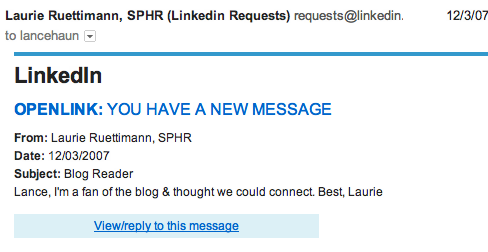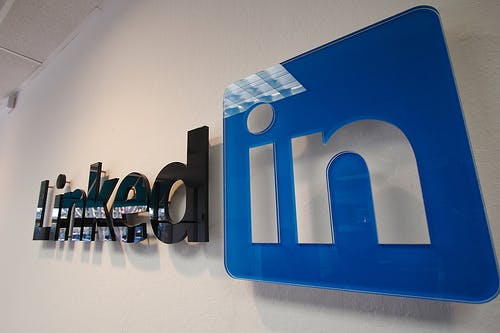This week has been LinkedIn week over at ERE.net, our sister publication. Make sure to check out a few of the articles including my favorite by Dr. John Sullivan.
I’m a big fan of LinkedIn. It helped me make contacts and placements when I was a recruiter. It helps me now to connect with potential stories and speakers for SourceCon.
Slowly but surely, LinkedIn has also become a less open place. And the temptation will be to continue to clamp down search and messaging capability until recruiters can’t breathe on their web browser without paying a cover charge. If LinkedIn takes that path, the end result will look a lot like a relic that everyone seems to hate on routinely: job boards.
The argument for openness
I joined LinkedIn relatively late for a typical early adopter. I came in after the site already had six million members. That was a little more than six years ago. Since then, I’ve grown my network (haphazardly at times) to a little over 1,200 connections. I dipped into open networking groups, especially when I was recruiting. I used LinkedIn to find names and message potential candidates. I accidentally sent LinkedIn invites to anyone I had ever sent an e-mail to in Gmail.
Most of the time, it acted like a network. In the earlier open days, I met many of the sourcing luminaries I know today through CSV lists distributed out. I even remember one particular blog reader reaching out to me in 2007:

The additions of groups and even the Q&A function greatly increased its functionality not just as a online resume database but as a legitimate business networking site. It was Facebook for adults. And a place where you could find good candidates, both those looking and those who weren’t necessarily thinking about it.
In the beginning, it was easier to message and find people. It led to serendipitous connections on occasion. But as soon as the first sales pitches and spam started hitting my inbox, I knew things would change. I just didn’t know how much.
The argument for a more closed LinkedIn
That’s when things got a bit more dicey. Soon enough, the free ways that people used to network with people on LinkedIn started disappearing. Messaging options started going away. Openlink network (which allows other people to contact you for free) is only available on a paid basis. InMails became a premium feature as well.
And in response, the site seemed to grow like crazy. As they’ve continued to tighten down information (sometimes in small ways) people continue to join and use the site. They don’t get hassled by sales people or recruiters as much and they can continue to tell their boss that they are using it for networking purposes only, not looking for a job.
Recruiting income playing a role?
For the first quarter of 2012, LinkedIn announced revenue. The not-so-shocker: hiring solutions makes up over half of their revenue and it is increasing (it was 49% in 1Q 2011 versus 54% in 1Q 2012). As LinkedIn becomes more dependent on recruiting income, there is going to be a temptation there to continue the lock down until they are a glorified job board and resume database.
While LinkedIn might not be maxed out for members worldwide, its US growth will continue to slow. And considering nearly two-thirds of their income comes from the US, there will be increasing pressure to get the most out of that.
So how do you do that? You start to make names and other information unavailable to anyone without a paid account. And even if your members want to be contacted and networked with, you won’t allow it (unless they pay, or the people who want to contact them pays). And certainly, if someone is using your API, you charge them or disallow them to use it (even if the product is pretty great).
Closing the walls
Last weekend, my step-dad and I were talking about LinkedIn. He’s not an HR or recruiting pro but he’s noticed the same thing that many of you have noticed: someone who is updating their profile a ton, adding and asking for recommendations and being more active on the site is looking for a new gig. That’s a problem.
The magic and power of LinkedIn is its openness for connecting with others, the great ways that even a casual user can use it for a legitimate purpose (tracking down people they need to talk to), the freshness of information, the way it is peer validated because it is open and the ability for someone to be on the site and not have anyone question whether or not they’re angling for another job. More importantly though, LinkedIn is a network of some hard-to-find people. A good one at that. At least right now.
But every time they disable contact or search functionality so that they can hopefully sell it as a service to a recruiter or salesperson, they lose a little piece of that magic. They step closer to giving people less of an incentive to keep their information up-to-date (because only recruiters and salespeople will be able to act on it).
Being a job board and a resume/contact database is a workable business model. No harm in that. But it’s not particularly novel (and the end game is pretty clear on it as well). Resume databases lack the passive candidates that every recruiter wants and contact databases are often full of old, outdated information.
Keep it open
LinkedIn is walking a fine line but they have to strive for openness as the default, not as the exception. If they want to keep the people who use LinkedIn as the legitimate default for business networking regardless of employment status (i.e. the thing that sets them apart in their customer’s eyes), they are going to have to keep it open and allow users to control their data and level of connectivity they prefer.
Yes, LinkedIn will lose money. Clever recruiters can get around paid roadblocks put into place on an open network.
But LinkedIn has a good set of recruiting search and contact products that could be really great (without taking away any of the openness of the network). Instead of putting formerly free features behind a paywall, create new features and add them to those paid tools for better functionality. Make it so finding and connecting with people as a professional recruiter is so much more fast when you use your internal tool, it would be foolish to waste effort on other methods.
Then? Increase openness. Encourage members to talk and share. And not just with paid accounts and paid InMails but between the free people too (you know, the people most of your recruiting customers want to talk to). Continue to build reasons for people to come back to the site. And I believe all that functionality is based on more openness.
Aside from lazy recruiters and job seekers, nobody wants LinkedIn to turn into a glorified job board and resume database. The value and uniqueness of the site drops as it gets closer to that too. I hope LinkedIn chooses open instead of chasing dollar signs into a smaller and smaller closed market. But maybe that’s just me.
